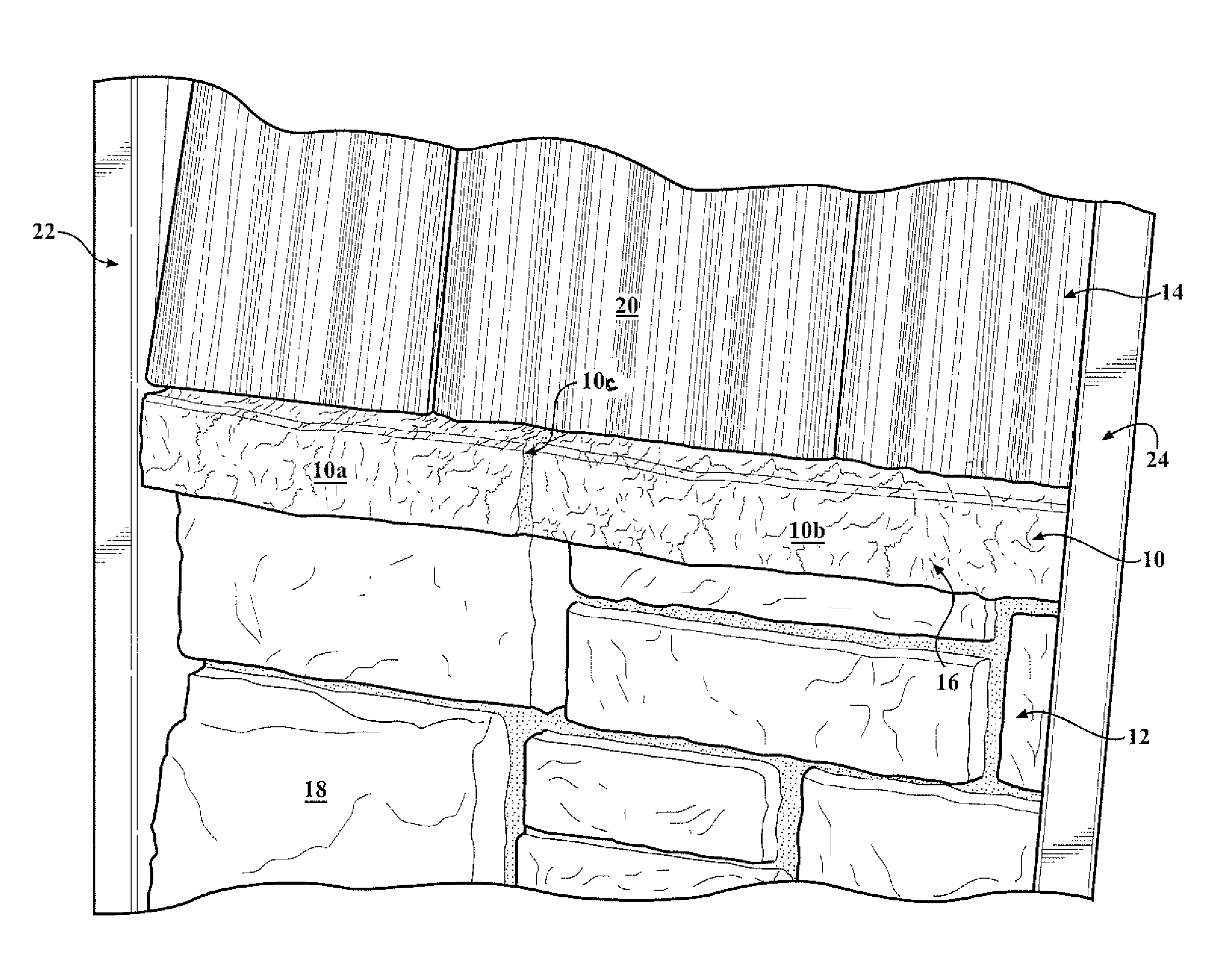System and method for manufacturing a rough textured molded plastic siding product
a technology of molded plastic siding and manufacturing method, which is applied in the direction of dough shaping, manufacturing tools, applications, etc., can solve the problems of limited embossing system and process, and the roughness of the resulting molded surface can be substantially limited, and achieve the effect of sufficient pliability
- Summary
- Abstract
- Description
- Claims
- Application Information
AI Technical Summary
Benefits of technology
Problems solved by technology
Method used
Image
Examples
first embodiment
[0024]Referring to FIG. 2, first embodiment manufacturing system 50 for manufacturing a rough-textured molded plastic product, such as lineal 10, includes the schematically shown portion of its extrusion production line. Except as noted herein, system 50 is generally of a known type.
[0025]To achieve the rougher, deeper surface texture of lineal 10, manufacturing system 50 includes an embossing element in the form of embossing roll 52 with a deeper than typical relief texture 521 in its steel circumferential embossing surface 522, and a backing roll 54 having a cylindrical coating or rim 541 formed of a soft rubber, such as silicone, that defines its circumferential surface 542. Coating 541 is elastically deformable and much softer than the typical heat resistant hard rubber typically used in prior backing rolls for vinyl lineal embossing processes, and has a radial thickness of approximately one inch. Rolls 52 and 54 are rotatable about their respective, parallel axes of rotation 52...
second embodiment
[0040]The axial lengths of belt rollers 76, 78, backing roll 80, and guide rollers 60, 62; the distance between belt roller axes 763, 783; and the width and length of belt 74, may all be made sufficiently large to accommodate molding large plastic products such as molded siding panels. Therefore, in addition to molded parts such as transition lineal 10, panels having rough surface textures could also be produced using second embodiment manufacturing system 50a. Multiple such panels, each with different, individual surface textures could also be molded using a single, suitably designed embossing belt 74 of adequate length. So configured, manufacturing system 50a may accommodate, with a single embossing belt 74, the production of a plurality of differently configured siding panels that would reduce the repetition of a common surface texture pattern in a plurality of panels installed on a building.
[0041]Thus, the second embodiment system 50a is capable of molding rough-textured surface...
third embodiment
[0044]Thus, in third embodiment system 50b and embossing stand 59b, the soft silicone rubber-rimmed backing roll 85 is positioned above embossing belt assembly 82. Supporting belt upper span 90 against downward movement away from backing roll 85 is belt support roller 92 that bears against the underside 902 of the belt's upper span. Backing roll 85 and the top side 901 of the belt's upper span 90 are in compressed engagement, and bear against each other through the thickness of material 40 in the contact patch.
[0045]Belt support roller 92 has an axis of rotation 923 parallel with axes 863 and 883 of belt rollers 86 and 88, and axis 853 of backing roll 85. Axes 853 and 923 are contained within substantially vertical imaginary plane 57b. The nip point, which in this embodiment is between the outer surface 842 of belt 84 and the circumference 852 of backing roll 85, is defined by a contact patch that is similar to contact patch 551 (FIG. 3), and extends well beyond both sides of imagin...
PUM
| Property | Measurement | Unit |
|---|---|---|
| radial thickness | aaaaa | aaaaa |
| compressive | aaaaa | aaaaa |
| shape | aaaaa | aaaaa |
Abstract
Description
Claims
Application Information
 Login to View More
Login to View More - R&D
- Intellectual Property
- Life Sciences
- Materials
- Tech Scout
- Unparalleled Data Quality
- Higher Quality Content
- 60% Fewer Hallucinations
Browse by: Latest US Patents, China's latest patents, Technical Efficacy Thesaurus, Application Domain, Technology Topic, Popular Technical Reports.
© 2025 PatSnap. All rights reserved.Legal|Privacy policy|Modern Slavery Act Transparency Statement|Sitemap|About US| Contact US: help@patsnap.com



